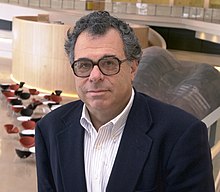David Botstein
| David Botstein | |
|---|---|
 |
|
| Born |
8 September 1942 (age 74) Zurich, Switzerland |
| Fields | Biology |
| Institutions |
MIT Stanford University Genentech Princeton University |
| Alma mater |
Harvard University University of Michigan |
| Thesis | The Synthesis and Maturation of Phage-P22 DNA (1967) |
| Doctoral students |
Olga Troyanskaya Nikolai Slavov Fred Winston Mark Rose Douglas Koshland Chris Kaiser Tim Stearns |
| Other notable students | Michael Eisen (postdoc) |
| Notable awards |
Eli Lilly and Company Award in Microbiology (1978) Genetics Society of America Medal (1988) Allan Award of the American Society of Human Genetics (1989) Gruber Prize in Genetics (2003) Albany Medical Center Prize (2010) Breakthrough Prize in Life Sciences (2013) Warren Alpert Foundation Prize (2013) |
|
Website www molbio |
|
David Botstein (born 8 September 1942) is an American biologist serving as the Chief Scientific Officer of Calico. He served as the director of the Lewis-Sigler Institute for Integrative Genomics at Princeton University from 2003–2013, where he remains an Anthony B. Evnin Professor of Genomics.
Botstein graduated from the Bronx High School of Science in 1959, and Harvard University in 1963. He started his Ph.D. work under Maurice Sanford Fox at the Massachusetts Institute of Technology, then moved and received a Ph.D. from the University of Michigan in 1967 for work on P22 phage.
Botstein taught at the Massachusetts Institute of Technology, where he became a Professor of Genetics. Botstein joined Genentech, Inc. in 1987 as Vice President-Science. In 1990, he became Chairman of the Department of Genetics at Stanford University. Dr. Botstein was elected to the U.S. National Academy of Sciences in 1981 and to the Institute of Medicine in 1993.
Botstein is the director of the Integrated Science Program at Princeton University. Many Integrated Science students have gone on to be successful in the field of molecular biology.
In 1980, Botstein and his colleagues Ray White, Mark Skolnick, and Ronald W. Davis proposed a method for constructing a genetic linkage map using restriction fragment length polymorphisms that was used in subsequent years to identify several human disease genes including Huntington's and BRCA1. Variations of this method were used in the mapping efforts that predated and enabled the sequencing phase of the Human Genome Project.
...
Wikipedia
